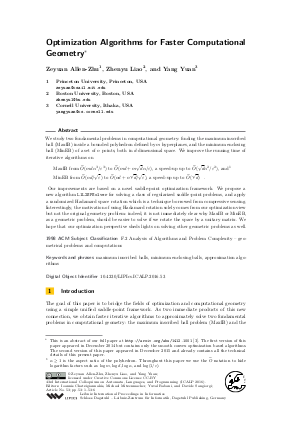Optimization Algorithms for Faster Computational Geometry
Authors Zeyuan Allen-Zhu, Zhenyu Liao, Yang Yuan
-
Part of:
Volume:
43rd International Colloquium on Automata, Languages, and Programming (ICALP 2016)
Part of: Series: Leibniz International Proceedings in Informatics (LIPIcs)
Part of: Conference: International Colloquium on Automata, Languages, and Programming (ICALP) - License:
 Creative Commons Attribution 3.0 Unported license
Creative Commons Attribution 3.0 Unported license
- Publication Date: 2016-08-23
File

PDF
LIPIcs.ICALP.2016.53.pdf
- Filesize: 424 kB
- 6 pages
Document Identifiers
Subject Classification
Keywords
- maximum inscribed balls
- minimum enclosing balls
- approximation algorithms
Metrics
- Access Statistics
-
Total Accesses (updated on a weekly basis)
0PDF Downloads0Metadata Views
Abstract
We study two fundamental problems in computational geometry: finding the maximum inscribed ball (MaxIB) inside a bounded polyhedron defined by m hyperplanes, and the minimum enclosing ball (MinEB) of a set of n points, both in d-dimensional space. We improve the running time of iterative algorithms on MaxIB from ~O(m*d*alpha^3/epsilon^3) to ~O(m*d + m*sqrt(d)*alpha/epsilon), a speed-up up to ~O(sqrt(d)*alpha^2/epsilon^2), and MinEB from ~O(n*d/sqrt(epsilon)) to ~O(n*d + n*sqrt(d)/sqrt(epsilon)), a speed-up up to ~O(sqrt(d)). Our improvements are based on a novel saddle-point optimization framework. We propose a new algorithm L1L2SPSolver for solving a class of regularized saddle-point problems, and apply a randomized Hadamard space rotation which is a technique borrowed from compressive sensing. Interestingly, the motivation of using Hadamard rotation solely comes from our optimization view but not the original geometry problem: indeed, it is not immediately clear why MaxIB or MinEB, as a geometric problem, should be easier to solve if we rotate the space by a unitary matrix. We hope that our optimization perspective sheds lights on solving other geometric problems as well.
Cite As Get BibTex
Zeyuan Allen-Zhu, Zhenyu Liao, and Yang Yuan. Optimization Algorithms for Faster Computational Geometry. In 43rd International Colloquium on Automata, Languages, and Programming (ICALP 2016). Leibniz International Proceedings in Informatics (LIPIcs), Volume 55, pp. 53:1-53:6, Schloss Dagstuhl – Leibniz-Zentrum für Informatik (2016)
https://doi.org/10.4230/LIPIcs.ICALP.2016.53
BibTex
@InProceedings{allenzhu_et_al:LIPIcs.ICALP.2016.53,
author = {Allen-Zhu, Zeyuan and Liao, Zhenyu and Yuan, Yang},
title = {{Optimization Algorithms for Faster Computational Geometry}},
booktitle = {43rd International Colloquium on Automata, Languages, and Programming (ICALP 2016)},
pages = {53:1--53:6},
series = {Leibniz International Proceedings in Informatics (LIPIcs)},
ISBN = {978-3-95977-013-2},
ISSN = {1868-8969},
year = {2016},
volume = {55},
editor = {Chatzigiannakis, Ioannis and Mitzenmacher, Michael and Rabani, Yuval and Sangiorgi, Davide},
publisher = {Schloss Dagstuhl -- Leibniz-Zentrum f{\"u}r Informatik},
address = {Dagstuhl, Germany},
URL = {https://drops.dagstuhl.de/entities/document/10.4230/LIPIcs.ICALP.2016.53},
URN = {urn:nbn:de:0030-drops-63325},
doi = {10.4230/LIPIcs.ICALP.2016.53},
annote = {Keywords: maximum inscribed balls, minimum enclosing balls, approximation algorithms}
}
Author Details
References
-
Pankaj K. Agarwal, Sariel Har-Peled, and Kasturi R. Varadarajan. Geometric approximation via coresets. Combinatorial and computational geometry, 52:1-30, 2005.

- Nir Ailon and Bernard Chazelle. Faster dimension reduction. Communications of the ACM, 53(May):97-104, 2010. URL: http://dx.doi.org/10.1145/1646353.1646379.
-
Zeyuan Allen-Zhu, Zhenyu Liao, and Yang Yuan. Optimization Algorithms for Faster Computational Geometry. ArXiv e-prints, abs/1412.1001, December 2014.

-
Zeyuan Allen-Zhu and Lorenzo Orecchia. Using optimization to break the epsilon barrier: A faster and simpler width-independent algorithm for solving positive linear programs in parallel. In Proceedings of the 26th ACM-SIAM Symposium on Discrete Algorithms, SODA'15, 2015.

-
Mihai Bădoiu and Kenneth L Clarkson. Optimal core-sets for balls. Computational Geometry, 40(1):14-22, 2008.

- Mihai Bădoiu, Sariel Har-Peled, and Piotr Indyk. Approximate clustering via core-sets. In Proceedings of the thiry-fourth annual ACM symposium on Theory of computing - STOC'02, page 250, New York, New York, USA, 2002. ACM Press. URL: http://dx.doi.org/10.1145/509907.509947.
-
Kenneth L Clarkson. Coresets, sparse greedy approximation, and the frank-wolfe algorithm. ACM Transactions on Algorithms (TALG), 6(4):63, 2010.

- Kenneth L. Clarkson, Elad Hazan, and David P. Woodruff. Sublinear optimization for machine learning. Journal of the ACM, 59(5):23:1-23:49, October 2012. URL: http://dx.doi.org/10.1145/2371656.2371658.
-
Jack Elzinga and Thomas G. Moore. A central cutting plane algorithm for the convex programming problem. Mathematical Programming, 8(1):134-145, 1975.

-
Bernd Gärtner and Martin Jaggi. Coresets for polytope distance. In Proceedings of the 25th annual symposium on computational geometry, pages 33-42. ACM, 2009.

-
Sariel Har-Peled, Dan Roth, and Dav Zimak. Maximum margin coresets for active and noise tolerant learning. In Proceedings of the 20th international joint conference on Artifical intelligence, pages 836-841. Morgan Kaufmann Publishers Inc., 2007.

- Piyush Kumar, Joseph S. B. Mitchell, and E. Alper Yildirim. Approximate minimum enclosing balls in high dimensions using core-sets. Journal of Experimental Algorithmics, 8:1-29, January 2003. URL: http://dx.doi.org/10.1145/996546.996548.
-
Chungmok Lee and Sungsoo Park. Chebyshev center based column generation. Discrete Applied Mathematics, 159(18):2251-2265, 2011.

-
Katta G. Murty. o(m) bound on number of iterations in sphere methods for lp. Algorithmic Operations Research, 7(1):30-40, 2012.

-
Yurii Nesterov. A method of solving a convex programming problem with convergence rate O(1/k²). In Doklady AN SSSR (translated as Soviet Mathematics Doklady), volume 269, pages 543-547, 1983.

- Yurii Nesterov. Excessive Gap Technique in Nonsmooth Convex Minimization. SIAM Journal on Optimization, 16(1):235-249, January 2005. URL: http://dx.doi.org/10.1137/S1052623403422285.
- Ankan Saha, S. V. N. Vishwanathan, and Xinhua Zhang. New Approximation Algorithms for Minimum Enclosing Convex Shapes. In Proceedings of the Twenty-Second Annual ACM-SIAM Symposium on Discrete Algorithms - SODA'11, pages 1146-1160, September 2011. URL: http://arxiv.org/abs/0909.1062.
-
James Joseph Sylvester. A question in the geometry of situation. Quarterly Journal of Pure and Applied Mathematics, 1, 1857.

-
Emo Welzl. Smallest enclosing disks (balls and ellipsoids). Springer, 1991.

- Yulai Xie, Jack Snoeyink, and Jinhui Xu. Efficient algorithm for approximating maximum inscribed sphere in high dimensional polytope. In Proceedings of the 22nd annual symposium on computational geometry - SCG'06, 2006. URL: http://dx.doi.org/10.1145/1137856.1137861.
-
E. Alper Yildirim. Two algorithms for the minimum enclosing ball problem. SIAM Journal on Optimization, 19(3):1368-1391, 2008.

- Yuchen Zhang and Lin Xiao. Stochastic Primal-Dual Coordinate Method for Regularized Empirical Risk Minimization. In Proceedings of the 32nd International Conference on Machine Learning, ICML 2015, 2015. URL: http://arxiv.org/abs/1409.3257.
